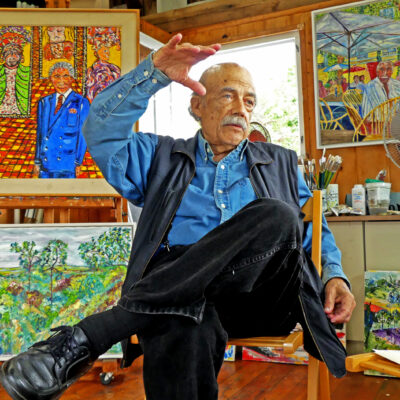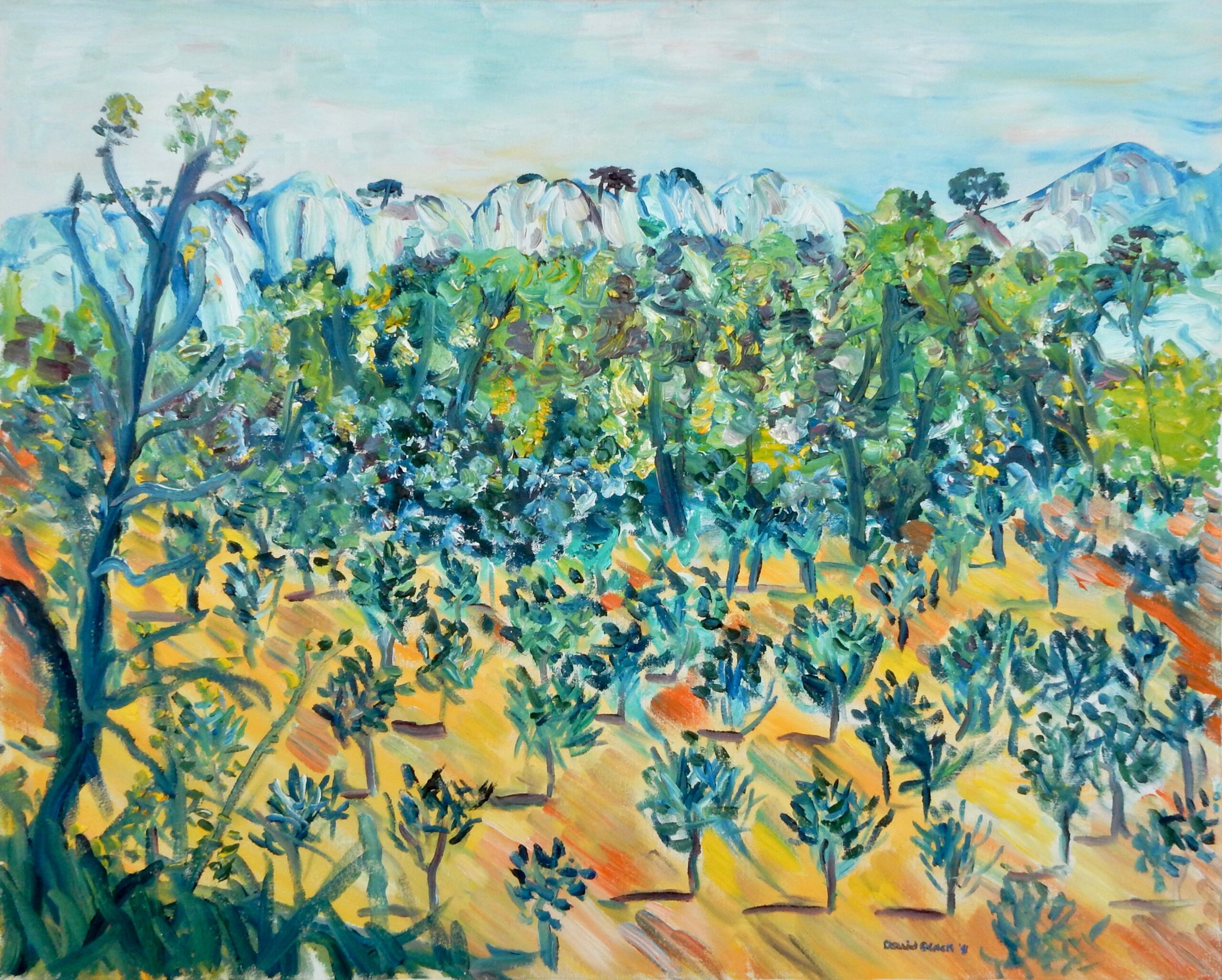About
David Black
1931 – 2022

Photo Credit: Harold Hanka
David Black did not intend to become an artist. He had been a violinist, opera singer, Tony Award-winning Broadway producer, actor, director, playwright, and author. In 1984, a collection of his drawings found their way to London’s Royal Academy artists John Hoyland and Patrick Caulfield, and both were immediately taken with Mr. Black’s innate skill. With their encouragement, Mr. Black fully applied himself to painting, remaining steadfastly self-taught throughout his life.
In 1988 Frederick Gore, Head of the Exhibition Committee of the Royal Academy, visited Black’s studio in New York. Gore selected forty of Black’s paintings for a solo exhibition in London which opened in 1990. In his introduction to the exhibition Gore wrote, “David Black is a serious painter and his paintings are fun. He paints what he likes, he paints what he has seen and he paints it with a sure sense of comedy, really wild comedy, but just too perceptive and observant to be called satire.” Gore called Black “an extraordinary natural talent and a voracious observer of humanity.”
Mr. Black was a native New Yorker,
and the city’s landscapes, crowds, and intimate gatherings were favorite subjects. These works move easily between frantic energy and quiet reflection. He was able to create a definite sense of place. This ability to capture the essential feel of an environment is clear in his paintings set in England, France, Morocco, Italy and Turkey. Closer to home, Las Vegas’ crass and raucous energy is instantly recognizable.
Mr. Black once said, “All of my paintings are influenced by my years in theater. And, what interests me most is when you actually see the drama and conflict between the colors.”
In all of his work, Mr. Black was sharply focused on the emotional world of his subjects. His paintings often told stories, but their center was always affective, always the swirling color of feeling.
Tunisian Collaborative Painting
Mr. Black was invited to Tunis through the Department of State’s Art In Embassies program where he discovered this unique method of collaborative painting. Hillary Rodham Clinton called Mr. Black “an honorary diplomat” for introducing Tunisian Collaborative Painting to the United States. Mr. Black has trained artists in this technique in both America, France and England.
View a short film of Mr. Black working at the Art Students League in New York using this technique.
Read The Wall Street Journal article about Mr. Black’s sessions at the Art Students League.
Author
Mr. Black wrote three books from his time in the theatre:
Falling off Broadway (2015), a memoir of Mr. Black’s adventures on Broadway.
The Magic of Theater (Scribner, 1994), a collection of interviews with such theater luminaries as Stockard Channing, Christopher Walken, Liv Ullman, Joel Grey, and Frank Langella.
The Actor’s Audition (Vintage, 1990), a practical, hands-on guide, covering every aspect of the auditioning process. A must for aspiring actors.
Art Acclaim
David Black is a serious painter. He paints what he likes, he paints what he has seen, and he paints it with a sure sense of comedy - really wild comedy - but just too perceptive and observant to be called satire. Black is an extraordinary natural talent and a voracious observer of humanity.
Frederick Gore C.B.E., Royal Academy, London
Art Acclaim
David Black's paintings are playful but in no way slight. The canvases are full of 'story,' but long before they take on an illustrational overload, they become painterly. Then you try looking at them as ornament, and their content asserts itself. This must be such an excruciatingly difficult trick to pull off that one assumes that Black does it by learned instinct, like swimming.
Anthony Haden-Guest Art Critic
Art Acclaim
David Black is a wonderful watcher. His painting of Pool is the best I've seen since Vincent Van Gogh. His compositions are wonderfully inventive and brave: full of visual surprises. When he paints his New York background he is at the heart of his culture. One feels the pain, understanding and sympathy he feels, as one does with everything he paints.
John Hoyland Royal Academy, London
Art Acclaim
Black's "...oils, bubbling with color, unabashedly tackle everything from landscape to social mores... the smug couple seated at a table in Benefit Dinner, the two old men playing chess beneath a stuffed deer's head in At the Club, the bilious crowd in The Backer's Audition are nicely observed New York vignettes."
Grace Glueck The New York Times
Art Acclaim
David Black's paintings Fontana di Trevi and Palio Square really capture Rome and Siena. In his Moroccan painting The Tea Lady, the setting and the depth of the background give the painting an air of mystery. His use of black in The Fruit Seller is excellent and Basket Square is daring and shows a great sense of color. Unlike some other artists, when Black paints different countries his paintings look like those countries. I also admire The Carousel. The composition and the horses and white balloons create a great sense of motion and color. The painting has a monumental quality. It belongs in a museum.
Will Barnet Artist
Art Acclaim
There is a commanding confidence in these paintings. The small, strikingly colored images of the vineyards of Provence echo the liberation and daring of Van Gogh's works. It would be wrong, however, to think of these paintings as slavish copies of the French Impressionist. Black's palette is immediately striking, idiosyncratic and bright, full of rich primary colors, and while it shares similarities with Van Gogh's palette, it is uniquely his own. In many ways it is just as pleasurably shocking to viewers today as Van Gogh's must have been at the turn of the century...
Sarah Stack Entertainment Weekly
Art Acclaim
The output by New Yorker David Black for this, his first UK exhibition, splits fairly naturally into landscape oils and acrylics and groups of heavily caricatured figures, almost gestural and filled with a childlike surprise. Works such as Hors d'oeuvres, and Maimonides Convention are obvious quick-fire, humorous comment on a slice of society known to the artist...Black's inspirational approach works when design combines with colour intensity like in the two Deauville paintings, or Indian Bathers, Benares where the overall pattern of figures strongly suggests the exotic generosity of Hindu temple carving. Spring in Union Square shows a marked handling of primary colours without resultant rawness, becoming one of the most appealing works here, while Trees on the Road in Spring, a thinly painted oil, exceptionally displays that elusive luminosity. For various reasons I liked Farmer's Market, At the Circus, Turkish Island, and The Mill House, North Stonington, but best of all is the wholly Post-Impressionist oil Rhododendrons and Azaleas. In this Black has taken a subject so loved by amateurs, and turned it into a monumental, powerfully impastoed, succinctly coloured, masterpiece.
Ray Rushton Arts Review


